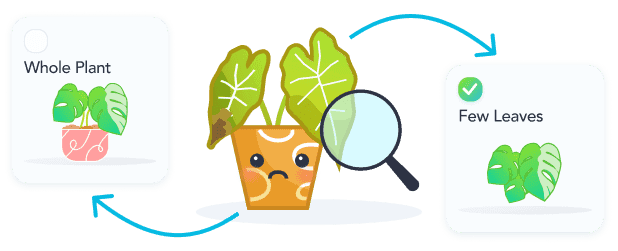Every 7d
Recommended Frequency
1 /2 cup of water
Recommended Amount
Bird's Nest Ferns prefer consistently moist soil, but make sure it is not soggy. Water your plant when the top inch becomes dry. Do not water directly into the center of your fern, as it can cause mold growth. Instead, w...
Every 30d
Recommended Frequency
Fertilize your Bird's Nest Fern during spring and summer using a 20-20-20 fertilizer diluted by half.
Indirect Sun
Recommended
Indirect Sun or Filtered Sun is when sun exposure is being filtered through a sheer curtain or is not able to have the sun's rays directly hit the leaves/flowers of your plant.
Every 730d
Recommended Frequency
Repot your Bird's Nest Fern every two years, or once it outgrows its pot.
Peat Soil
Recommended Soil
Peat Soil is an acidic soil that retains a lot of moisture and slows decomposition. Due to such a high moisture retention this mix may require irrigation to help with draining. This soil type is best used when paired wit...

Shop Birds Nest Fern
Questions about Birds Nest Fern
A Bird's Nest Fern is an epiphytic plant known for its lush, ripple-edged fronds that resemble a bird's nest. Thriving in warm, humid environments, it's perfect for indoor spaces, requiring indirect light and consistent ...

Toxicity of Birds Nest Fern

Common Pests and Diseases
Root Rot
Overwatering
To address root rot in birds nest fern, first, remove the plant from its pot and trim away any black, mushy roots, leaving only healthy, firm roots. Allow the roots to air dry before repotting in fresh, well-draining soil. Ensure the pot has adequate drainage holes. Going forward, water the plant only when the top inch of soil feels dry to the touch, and avoid letting water accumulate in the center of the plant.
Brown and Crispy Edges
Underwatering
Birds nest ferns prefer consistently moist soil but not waterlogged conditions. To address underwatering, gradually increase watering frequency, ensuring the top inch of soil feels slightly moist to the touch. Avoid letting the plant sit in water by ensuring proper drainage. If your environment is particularly dry, consider increasing humidity around the plant through a pebble tray with water or a humidifier. Regularly check the soil moisture and adjust your watering schedule accordingly to prevent recurrence.
Scale Insects
Scale insects are small, sap-sucking pests that attach themselves to the leaves and stems of plants, including the bird's nest fern. They can cause yellowing of leaves, stunted growth, and in severe cases, plant death.
To manage scale insects, start by manually removing them with a soft brush or cloth dipped in soapy water. For more severe infestations, apply neem oil or insecticidal soap directly to the affected areas, ensuring to cover both sides of the leaves. Repeat the treatment every 7-10 days until the infestation is under control. Always test a small area first to ensure the plant's sensitivity to the treatment.
Brown Spots on Leaves
Fungal Infection
Fungal infections in Bird's Nest Fern often result from high humidity combined with poor air circulation. To address this, ensure the plant is in a well-ventilated area and reduce humidity if excessively high. Remove affected leaves with sterilized scissors to prevent the spread of the fungus. Additionally, applying a fungicide may be necessary, but always choose one that is safe for ferns. Avoid overhead watering to keep the leaves dry and reduce the risk of future infections.

Related Plants
Other Articles:
Top 10 Most Popular Roses
Mar 22, 2022
How to Care for China Roses
Mar 11, 2022
How to Care for Chinese Money Plants
May 15, 2020
How to Grow and Care for A Bird of Paradise
Apr 26, 2020
Top 10 Plants To Grow In A Terrarium
May 31, 2022
How to Grow and Care for Lucky Bamboo
Mar 29, 2022
How to Grow and Care for Corn Plants
Mar 29, 2022
How to Care for Madagascar Dragon Trees
Mar 21, 2022



